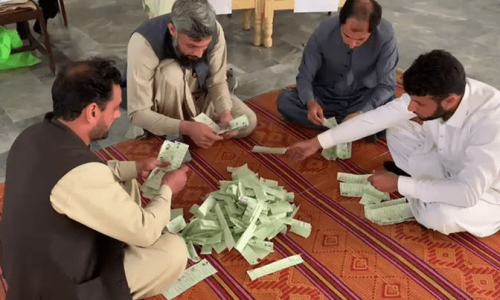UMERKOT: The drought-like condition in Tharparkar district claimed the lives of nine more infants on Tuesday, putting the total number of child deaths from malnutrition to an alarming 100 in nearly two months.
The death toll from tehsil Chhachhro rose to six, with reports of three more infant deaths in Hayat Halepoto village. Three infants had died earlier today in village Alamsar of tehsil Chhachhro.
Earlier, two other children died at the Civil Hospital in Mithi. The death of another infant was reported from tehsil Diplo, raising the total number of deaths on Tuesday to nine.
Doctors told Dawn today that the reasons behind the deaths were malnutrition, pneumonia and diarrhoea.
A medical practitioner also said that the district lacked basic health and hygiene education, adding that early marriages, births through unskilled attendants and lack of proper medical facilities were causing weakness in children.
Read: Tharparkar’s dry spell
In a recently released report by the District Health Department in Umerkot, it emerged that 85 people have died in Umerkot out of which 61 were infants. Another death was reported from district Umerkot on Tuesday.
The collated death toll in 2014 is reported to be above 470.
The deaths represent those areas where journalists are able to gain access. However, deaths of scores of infants, who have died in villages and private clinics, cannot be reported.
Tharparkar is spread over 22,000 square kilometers, with a population of about 1.5 million people. At an average, every third year is a drought year. The region faces famine at least once every decade.
Read: PPP, MQM busy politicking over Thar
More than 80 per cent of the people’s livelihood is dependent on rain-fed agriculture and livestock. In fact, livestock, fully or partially, contributes to the economy of every household in the district.
The dry spell in Tharparkar district — which has been ongoing over the last three years (2012-2014) — continues to deprive local growers of their main crops: cluster beans and millet.
And the prolonged drought conditions have forced different community groups, especially those who maintain small landholdings and family livestock, to migrate to neighbouring areas in search of livelihood.
Read: Drought report exposes rifts and chaos within PPP
However, Sindh Chief Minister Syed Qaim Ali Shah had brushed aside last week the allegations of slackness, negligence and incompetence on part of the provincial government in meeting the challenge of the Tharparkar drought and said it had realised the situation in November and started taking measures to meet the situation.













































